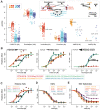Decrypting drug actions and protein modifications by dose- and time-resolved proteomics
- PMID: 36926954
- PMCID: PMC7615311
- DOI: 10.1126/science.ade3925
Decrypting drug actions and protein modifications by dose- and time-resolved proteomics
Abstract
Although most cancer drugs modulate the activities of cellular pathways by changing posttranslational modifications (PTMs), little is known regarding the extent and the time- and dose-response characteristics of drug-regulated PTMs. In this work, we introduce a proteomic assay called decryptM that quantifies drug-PTM modulation for thousands of PTMs in cells to shed light on target engagement and drug mechanism of action. Examples range from detecting DNA damage by chemotherapeutics, to identifying drug-specific PTM signatures of kinase inhibitors, to demonstrating that rituximab kills CD20-positive B cells by overactivating B cell receptor signaling. DecryptM profiling of 31 cancer drugs in 13 cell lines demonstrates the broad applicability of the approach. The resulting 1.8 million dose-response curves are provided as an interactive molecular resource in ProteomicsDB.
Conflict of interest statement
BK and MW are founders and shareholders of OmicScouts and MSAID. They have no operational role in either company. HH is co-founder, shareholder and CEO of OmicScouts. TH, LR, AyS, and GS are present or past employees of OmicScouts. JZ is currently an employee of AstraZeneca, SvW an employee of Novartis, and FMH an employee of OmicEra Diagnostics GmbH, but all of the work in this study has been performed while at TUM. All other authors declare no competing interests.
Figures





Comment in
-
Decrypting drug action at the level of PTMs.Nat Rev Drug Discov. 2023 May;22(5):355. doi: 10.1038/d41573-023-00052-6. Nat Rev Drug Discov. 2023. PMID: 37020011 No abstract available.
References
-
- Benns HJ, Wincott CJ, Tate EW, Child MA. Activity- and reactivity-based proteomics: Recent technological advances and applications in drug discovery. Curr Opin Chem Biol. 2021;60:20–29. - PubMed
-
- Lill JR, Mathews WR, Rose CM, Schirle M. Proteomics in the pharmaceutical and biotechnology industry: a look to the next decade. Expert Rev Proteomics. 2021;18:503–526. - PubMed
-
- Savitski MM, et al. Tracking cancer drugs in living cells by thermal profiling of the proteome. Science. 2014;346:1255784. - PubMed
MeSH terms
Substances
Grants and funding
LinkOut - more resources
Full Text Sources
Molecular Biology Databases
Miscellaneous

